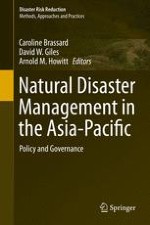2015 | OriginalPaper | Chapter
12. Building the Urban Community Disaster Relief System in China
Author : Songyan Chu
Published in: Natural Disaster Management in the Asia-Pacific
Publisher: Springer Japan
Activate our intelligent search to find suitable subject content or patents.
Select sections of text to find matching patents with Artificial Intelligence. powered by
Select sections of text to find additional relevant content using AI-assisted search. powered by
